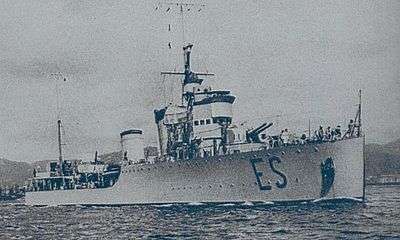Turbine-class destroyer
 Espero at anchor | |
| Class overview | |
|---|---|
| Name: | Turbine class |
| Operators: | |
| In commission: | 1927–1943 |
| Completed: | 8 |
| Lost: | 8 |
| General characteristics | |
| Type: | Destroyer |
| Displacement: |
|
| Length: | 93.2 m (305 ft 9 in) |
| Beam: | 9.2 m (30 ft 2 in) |
| Draught: | 3 m (9 ft 10 in) |
| Installed power: | |
| Propulsion: |
|
| Speed: |
|
| Range: | 3,200 nmi (5,900 km; 3,700 mi) at 14 knots (26 km/h; 16 mph) |
| Complement: | 179 |
| Armament: |
|
The Turbine-class destroyer was a class of destroyers built for the Italian Regia Marina in the late 1920s. They were essentially larger versions of the earlier Sella-class destroyer. All the ships of the class were lost during World War II.
Ships
| Ship | Builder | Launched | Date of loss | Fate |
|---|---|---|---|---|
| Aquilone | Odero | 3 August 1927 | 17 September 1940 | Sunk on mines laid by aircraft from HMS Illustrious outside Benghazi harbor with a loss of 13 men. |
| Borea | Ansaldo | 28 January 1927 | 17 September 1940 | Sunk by aircraft from HMS Illustrious in Benghazi harbor with a loss of one man. |
| Espero | Ansaldo | 31 August 1927 | 28 June 1940 | Sunk by HMAS Sydney off Tobruk during a troop transport mission to Tobruk. |
| Euro | CNT | 7 July 1927 | 3 October 1943 | Sunk by German aircraft off Leros, Greece. |
| Nembo | CNT | 27 January 1927 | 20 July 1940 | Sunk by Swordfish torpedo bombers from HMS Eagle in Tobruk harbor with a loss of 25 men. |
| Ostro | Ansaldo | 2 January 1928 | 20 July 1940 | Sunk by Swordfish torpedo bombers from HMS Eagle in Tobruk harbor with a loss of 42 men. |
| Turbine | Odero | 21 April 1927 | 16 September 1944 | Sunk by rockets fired by USAAF aircraft in Salamis. |
| Zeffiro | Ansaldo | 27 May 1927 | 5 July 1940 | Sunk by Swordfish torpedo bombers from HMS Eagle in Tobruk with a loss of 21 men. |
History
.jpg)
During the Spanish Civil War, the Italian Navy supported the Spanish Nationalists not only by assisting them with war supplies, but also through undercover operations against enemy shipping. In the course of these missions, the destroyer Ostro torpedoed and sank the Spanish Republican freighter Conde de Abasolo on 13 August 1937,[1] while Turbine sank the Soviet Timiryazev by the same means on 30 August, both of them off Algeria.[2]
At the beginning of World War II, when Italy declared war against Britain and France, all eight ships of the Turbine class were based in Tobruk, Libya. They were tasked with mine laying duties and running supplies between Tobruk and Taranto. On 16 June 1940, Turbine sank the British submarine HMS Orpheus just off Tobruk.[3]
Turbine, Aquilone and Nembo took part in the shelling of Sollum on 14 June 1940. They repeated this action on 26 June.[4]
On 28 June 1940, Espero, Ostro and Zeffiro were in convoy, heavily loaded down with cargo, when they were intercepted by a British task force of five ships. In the ensuing battle, HMAS Sydney sank Espero as it lagged behind to allow the other two destroyers to reach Benghasi and later Tobruk safely.[5]
On 5 July 1940, British aircraft carrier HMS Eagle launched an attack on Tobruk harbor. Its Fairey Swordfish torpedo bombers sank Zeffiro, and severely damaged Euro. Later that month, on 20 July, during another attack on Tobruk harbour, other Swordfish from HMS Eagle sank with torpedoes both Nembo and Ostro. On 17 September of the same year, Swordfish from HMS Illustrious attacked Benghazi harbor where Aquilone and Borea were berthed, and both were sunk.[6] Euro was part of the escort of the ill-fated Duisburg convoy, when her commander lost the opportunity of torpedoing the cruiser HMS Aurora due to an error of identification. On 3 July 1942, while escorting three freighters from Taranto to Benghazi along with the Navigatori-class destroyer Da Verrazzano, Euro and Turbine shot down two Beaufort bombers.[7]
After Italy signed the Armistice of Cassibile in September 1943, Euro participated in the Battle of Leros where she was sunk by German Junkers Ju 87 "Stuka" dive bombers during an air raid on October 3, 1943.[8] Turbine was seized by the Kriegsmarine and put into service in the Aegean Sea as a torpedo boat. On 19 June 1944, at Porto Lago, she was badly damaged by an explosion, which was thought to have been sabotage. She set in to the port of Salamis for repairs, but a US air strike on the port on 16 September sunk her before they could be entirely completed.[9]
Notes
- ↑ González Etchegaray, Rafael (1977). La Marina Mercante y el Trafico Maritimo en la Guerra Civil. Editorial San Martin, p. 416. ISBN 84-7140-150-9 (in Spanish)
- ↑ Rohwer, Jürgen and Monakov, Mikhail (2001). Stalin's ocean-going fleet: Soviet naval strategy and shipbuilding programmes, 1935-1953. Routledge, p. 66. ISBN 0-7146-4895-7
- ↑ HMS Orpheus (N 46) from u-boat.net
- ↑ Rohwer, Jürgen and Hümmelchen, Gerhard (1992). Chronology of the war at sea 1939-1945: the naval history of World War two. Naval Institute Press, p.24. ISBN 1-55750-105-X
- ↑ Greene, Jack & Massignani, Alessandro (1998). The Naval War in the Mediterranean, 1940–1943, Chatam Publishing, London, pp. 63–65. ISBN 1-86176-057-4
- ↑ Aircraft Carrier Warfare, 1939-41, from Naval-History.net
- ↑ Shores, Cull & Malizia (1991). Malta: The Spitfire Year 1942. Grub Street, p. 387. ISBN 0-948817-16-X
- ↑ Comando Supremo, Events of 1943
- ↑ Kriegsmarine history page
External links
![]()